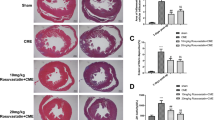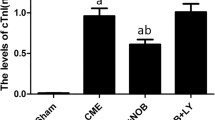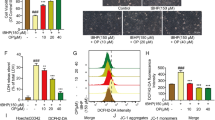Abstract
Coronary microembolization (CME) caused by physical obstruction in coronary microcirculation induces myocardial apoptosis and cardiac dysfunction, and it was reported that the inactivation of the Nrf2/HO-1 signaling was involved in this process. Astaxanthin (AST) is a reddish pigment that belongs to keto-carotenoids. It is also a potent antioxidant and has been reported to activate Nrf2/HO-1 signaling in vein endothelial cells. However, it is still unknown whether AST is able to activate Nrf2/HO-1 signaling pathway to protect cardiac functions from CME in vivo. To address this question, rats were orally administrated with AST or AST plus Zinc protoporphyrin IX (ZnPP, a HO-1 inhibitor), followed by CME modeling operation. Then, cardiac function was evaluated by echocardiographic measurement. Myocardial infarction was measured by HBFP staining, and apoptosis was assessed by TUNEL staining. The protein levels and mRNA expressions of Bax and Bcl-2 were measured by Western blot and qRT-PCR, respectively. ELISA was performed to measure the activity of enzymes related to oxidative stress. AST pretreatment dramatically attenuated CME-induced cardiac dysfunction, myocardial infarction, and cardiomyocyte apoptosis. Mechanistically, AST suppressed CME-induced oxidative stress by re-activating Nrf2/HO-1 signaling. HO-1 inhibitor ZnPP completely eliminated the benefits of AST in CEM, supporting the critical role of Nrf2/HO-1 signaling in mediating the cardioprotective function of AST in CME. Conclusion: AST suppresses oxidative stress via activating Nrf2/HO-1 pathway and thus prevents CME-induced cardiomyocyte apoptosis and ameliorates cardiac dysfunction in rats.






Similar content being viewed by others
Change history
24 January 2024
This article has been retracted. Please see the Retraction Notice for more detail: https://doi.org/10.1007/s00210-024-02967-2
References
Adams JM, Cory S (2018) The BCL-2 arbiters of apoptosis and their growing role as cancer targets. Cell Death Differ 25:27–36
Adluri RS, Thirunavukkarasu M, Zhan L, Maulik N, Svennevig K, Bagchi M, Maulik G (2013) Cardioprotective efficacy of a novel antioxidant mix VitaePro against ex vivo myocardial ischemia-reperfusion injury. Cell Biochem Biophys 67:281–286
Chen ZW, Qian JY, Ma JY, Chang SF, Yun H, Jin H, Sun AJ, Zou YZ, Ge JB (2014) TNF-alpha-induced cardiomyocyte apoptosis contributes to cardiac dysfunction after coronary microembolization in mini-pigs. J Cell Mol Med 18:1953–1963
Choi S, Koo S (2005) Efficient syntheses of the keto-carotenoids canthaxanthin, astaxanthin, and astacene. J Org Chem 70:3328–3331
Cory S, Adams JM (2002) The Bcl2 family: regulators of the cellular life-or-death switch. Nat Rev Cancer 2:647–656
Czabotar PE, Lessene G, Strasser A, Adams JM (2014) Control of apoptosis by the BCL-2 protein family: implications for physiology and therapy. Nat Rev Mol Cell Biol 15:49–63
Gross GJ, Lockwood SF (2005) Acute and chronic administration of disodium disuccinate astaxanthin (Cardax) produces marked cardioprotection in dog hearts. Mol Cell Biochem 272:221–227
He W, Su Q, Liang J, Sun Y, Wang X, Li L (2018) The protective effect of nicorandil on cardiomyocyte apoptosis after coronary microembolization by activating Nrf2/HO-1 signaling pathway in rats. Biochem Biophys Res Commun 496:1296–1301
Heusch G, Kleinbongard P, Bose D, Levkau B, Haude M, Schulz R, Erbel R (2009) Coronary microembolization: from bedside to bench and back to bedside. Circulation 120:1822–1836
Heusch G, Skyschally A, Kleinbongard P (2018) Coronary microembolization and microvascular dysfunction. Int J Cardiol 258:17–23
Hur W, Gray NS (2011) Small molecule modulators of antioxidant response pathway. Curr Opin Chem Biol 15:162–173
Hussein G, Sankawa U, Goto H, Matsumoto K, Watanabe H (2006) Astaxanthin, a carotenoid with potential in human health and nutrition. J Nat Prod 69:443–449
Kang MH, Reynolds CP (2009) Bcl-2 inhibitors: targeting mitochondrial apoptotic pathways in cancer therapy. Clin Cancer Res 15:1126–1132
Kensler TW, Egner PA, Agyeman AS, Visvanathan K, Groopman JD, Chen JG, Chen TY, Fahey JW, Talalay P (2013) Keap1-nrf2 signaling: a target for cancer prevention by sulforaphane. Top Curr Chem 329:163–177
Kidd P (2011) Astaxanthin, cell membrane nutrient with diverse clinical benefits and anti-aging potential. Altern Med Rev 16:355–364
Li Z, Dong X, Liu H, Chen X, Shi H, Fan Y, Hou D, Zhang X (2013) Astaxanthin protects ARPE-19 cells from oxidative stress via upregulation of Nrf2-regulated phase II enzymes through activation of PI3K/Akt. Mol Vis 19:1656–1666
Liang J, Li L, Sun Y, He W, Wang X, Su Q (2017) The protective effect of activating Nrf2 / HO-1 signaling pathway on cardiomyocyte apoptosis after coronary microembolization in rats. BMC Cardiovasc Disord 17:272
Loboda A, Damulewicz M, Pyza E, Jozkowicz A, Dulak J (2016) Role of Nrf2/HO-1 system in development, oxidative stress response and diseases: an evolutionarily conserved mechanism. Cell Mol Life Sci 73:3221–3247
Niu T, Xuan R, Jiang L, Wu W, Zhen Z, Song Y, Hong L, Zheng K, Zhang J, Xu Q, Tan Y, Yan X, Chen H (2018) Astaxanthin induces the Nrf2/HO-1 antioxidant pathway in human umbilical vein endothelial cells by generating trace amounts of ROS. J Agric Food Chem 66:1551–1559
Otterbein LE, Soares MP, Yamashita K, Bach FH (2003) Heme oxygenase-1: unleashing the protective properties of heme. Trends Immunol 24:449–455
Scherer AT, Masi AT (1975) Technical aspects of the haematoxylin—basic Fuchsin—picric acid (HBFP) stain applied to skeletal muscle. Histochem J 7:335–341
Su Q, Li L, Liu YC, Zhou Y, Lu YG, Wen WM (2013) Effect of metoprolol on myocardial apoptosis and caspase-9 activation after coronary microembolization in rats. Exp Clin Cardiol 18:161–165
Wang HQ, Sun XB, Xu YX, Zhao H, Zhu QY, Zhu CQ (2010) Astaxanthin upregulates heme oxygenase-1 expression through ERK1/2 pathway and its protective effect against beta-amyloid-induced cytotoxicity in SH-SY5Y cells. Brain Res 1360:159–167
Wolf AM, Asoh S, Hiranuma H, Ohsawa I, Iio K, Satou A, Ishikura M, Ohta S (2010) Astaxanthin protects mitochondrial redox state and functional integrity against oxidative stress. J Nutr Biochem 21:381–389
Xu C, Li CY, Kong AN (2005) Induction of phase I, II and III drug metabolism/transport by xenobiotics. Arch Pharm Res 28:249–268
Xu L, Zhu J, Yin W, Ding X (2015) Astaxanthin improves cognitive deficits from oxidative stress, nitric oxide synthase and inflammation through upregulation of PI3K/Akt in diabetes rat. Int J Clin Exp Pathol 8:6083–6094
Youn HS, Lee JY, Saitoh SI, Miyake K, Kang KW, Choi YJ, Hwang DH (2006) Suppression of MyD88- and TRIF-dependent signaling pathways of toll-like receptor by (−)-epigallocatechin-3-gallate, a polyphenol component of green tea. Biochem Pharmacol 72:850–859
Author information
Authors and Affiliations
Contributions
Yugang Xue, Chuang Sun, Qimeng Hao conducted the experiments and analyzed the data; Jin Cheng conceived and designed the research and wrote the manuscript. All the authors read and approved the manuscript.
Corresponding author
Ethics declarations
Conflicts of interest
The authors declare that they have no conflict of interest.
Research involving human participants and/or animals
All applicable international, national, and/or institutional guidelines for the care and use of animals were followed.
Informed consent
Not applicable.
Additional information
Publisher’s note Springer Nature remains neutral with regard to jurisdictional claims in published maps and institutional affiliations.
This article has been retracted. Please see the retraction notice for more detail: https://doi.org/10.1007/s00210-024-02967-2
Rights and permissions
Springer Nature or its licensor (e.g. a society or other partner) holds exclusive rights to this article under a publishing agreement with the author(s) or other rightsholder(s); author self-archiving of the accepted manuscript version of this article is solely governed by the terms of such publishing agreement and applicable law.
About this article
Cite this article
Xue, Y., Sun, C., Hao, Q. et al. RETRACTED ARTICLE: Astaxanthin ameliorates cardiomyocyte apoptosis after coronary microembolization by inhibiting oxidative stress via Nrf2/HO-1 pathway in rats. Naunyn-Schmiedeberg's Arch Pharmacol 392, 341–348 (2019). https://doi.org/10.1007/s00210-018-1595-0
Received:
Accepted:
Published:
Issue Date:
DOI: https://doi.org/10.1007/s00210-018-1595-0




